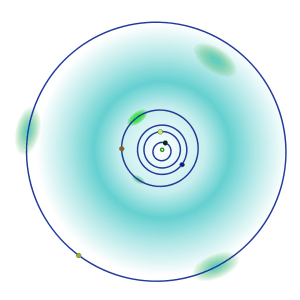5261 Eureka
| Discovery[1] | |
|---|---|
| Discovered by | David H. Levy and Henry Holt |
| Discovery date | 20 June 1990 |
| Designations | |
| Pronunciation | /jʊˈriːkə/ |
Named after | Eureka |
| 1990 MB | |
Martian L5  | |
| Orbital characteristics[2] | |
| Epoch 13 January 2016 (JD 2457400.5) | |
| Uncertainty parameter 0 | |
| Observation arc | 13267 days (36.32 yr) |
| Aphelion | 1.6222 AU (242.68 Gm) |
| Perihelion | 1.4249 AU (213.16 Gm) |
| 1.5236 AU (227.93 Gm) | |
| Eccentricity | 0.064766 |
| 1.88 yr (686.89 d) | |
Average orbital speed | 24.11 km/s |
| 145.29° | |
| 0° 31m 26.76s / day | |
| Inclination | 20.280° |
| 245.057° | |
| 95.456° | |
| Known satellites | 1 |
| Earth MOID | 0.497052 AU (74.3579 Gm) |
| Jupiter MOID | 3.52162 AU (526.827 Gm) |
| Jupiter Tisserand parameter | 4.428 |
| Physical characteristics | |
| Dimensions |
1.3[3] km ~2–4 kmH |
| 2.6902 h (0.11209 d) | |
| 0.39[3] | |
| Temperature | ~250[3] K |
| S(I)[3] (Gaffey) | |
| 16.0,[3] 16.1[2] | |
|
| |
5261 Eureka is the first Mars trojan discovered.[4] It was discovered by David H. Levy and Henry Holt at Palomar Observatory on June 20, 1990 from the Palomar Observatory.[1] It trails Mars (at the L5 point) at a distance varying by only 0.3 AU during each revolution (with a secular trend superimposed, changing the distance from 1.5–1.8 AU around 1850 to 1.3–1.6 AU around 2400). Minimum distances from the Earth, Venus, and Jupiter, are 0.5, 0.8, and 3.5 AU, respectively.
Long-term numerical integration shows that the orbit is stable. Kimmo A. Innanen and Seppo Mikkola note that "contrary to intuition, there is clear empirical evidence for the stability of motion around the L4 and L5 points of all the terrestrial planets over a timeframe of several million years".
Since the discovery of 5261 Eureka, the Minor Planet Center has recognized three other asteroids as Martian trojans: 1999 UJ7 at the L4 point, 1998 VF31 at the L5 point,[4] and 2007 NS2, also at the L5 point.[5] At least five other asteroids in near-1:1 resonances with Mars have been discovered, but they do not exhibit trojan behavior. They are 2001 FR127, 2001 FG24, (36017) 1999 ND43, 1998 QH56 and (152704) 1998 SD4.
The infrared spectrum for 5261 Eureka is typical for an A-type asteroid, but the visual spectrum is consistent with an evolved form of achondrite called an angrite. A-class asteroids are tinted red in hue, with a moderate albedo. The asteroid is located deep within a stable Lagrangian zone of Mars, which is considered indicative of a primordial origin—meaning the asteroid has most likely been in this orbit for much of the history of the Solar System.
Satellite
| Discovery | |
|---|---|
| Discovery date | November 28, 2011 |
| Orbital characteristics | |
| Epoch December 09 2014 | |
| 2.1 km | |
| 0.7054 ± 0.0004 d | |
| Physical characteristics | |
| Dimensions | 0.46 km |
|
| |
On November 28, 2011, a natural satellite of 5261 Eureka was found. It has yet to be named, and its provisional designation is S/2011 (5261) 1. The moon is about 0.46 km in diameter and orbits 2.1 km from Eureka. The satellite's existence was announced in September 2014.[6]
See also
References
- 1 2 Schmadel, Lutz D. (2003), Dictionary of minor planet names, Physics and astronomy online library (5th ed.), Springer, p. 452, ISBN 3-540-00238-3
- 1 2 Yeomans, Donald K., "5261 Eureka (1990 MB)", JPL Small-Body Database Browser, NASA, retrieved 13 April 2016.
- 1 2 3 4 5 Rivkin, Andrew S.; Trilling, David E.; Thomas, Cristina A.; DeMeo, Francesca; Spahr, Timothy B.; Binzel, Richard P. (December 2007), "Composition of the L5 Mars Trojans: Neighbors, not siblings", Icarus, 192 (2): 434–441, arXiv:0709.1925
 , Bibcode:2007Icar..192..434R, doi:10.1016/j.icarus.2007.06.026.
, Bibcode:2007Icar..192..434R, doi:10.1016/j.icarus.2007.06.026. - 1 2 "List of Martian Trojans". Retrieved 2011-02-26.
- ↑ MPEC 2007-O09 : 2007 NS2
- ↑ Johnston, Robert (November 16, 2014). "(5261) Eureka". Johnston's Archive. Retrieved September 6, 2015.
- Further reading
- IAUC 5045
- IAUC 5047
- IAUC 5067
- IAUC 5075
- A. S. Rivkin, R. P. Binzel, S. J. Bus, and J. A. Grier, "Spectroscopy and Classification of Mars Trojan Asteroids", Bulletin of the American Astronomical Society 34, 2002, p. 840.
- S. Tabachnik and N. W. Evans, "Cartography for Martian Trojans", The Astrophysical Journal 517, 1999, pp. L63-L66.
External links
- The co-orbital asteroids of Mars A simulation and animation showing Mars's co-orbital and near co-orbital asteroids
- 5261 Eureka at the JPL Small-Body Database
